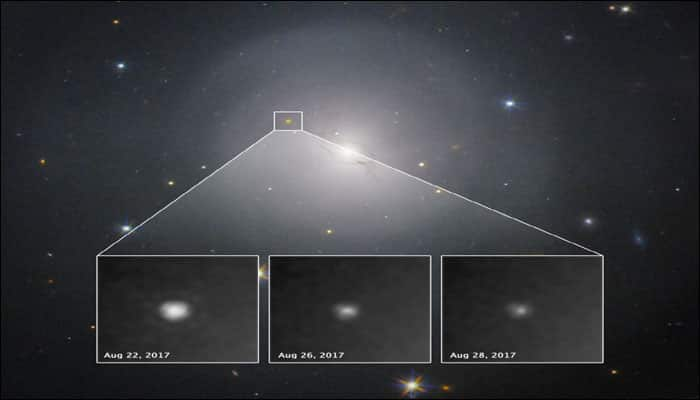New Delhi: Ever since the announcement of the first ever direct observation of gravitational waves caused by two neutron stars on Tuesday, has sent the scientific realm buzzing with excitement.
Unlike previously detected gravitational waves, these were accompanied by light, allowing astronomers to pinpoint the source.
The discovery was made on August 17 and NASA's Hubble Space Telescope turned its keen eye the new beacon, obtaining both images and spectra.
The resulting data will help reveal details of the titanic collision that created the gravitational waves, and its aftermath.
Merely two seconds after the detection of the ripples, NASA’s Fermi Gamma-ray Space Telescope measured a short pulse of gamma rays known as a gamma-ray burst.
Many observatories, including space telescopes, probed the suspected location of the source, and within about 12 hours several spotted their quarry.
According to NASA, in a distant galaxy called NGC 4993, about 130 million light-years from Earth, a point of light shone where nothing had been before. It was about a thousand times brighter than a variety of stellar flare called a nova, putting it in a class of objects astronomers call “kilonovae.” It also faded noticeably over six days of Hubble observations.
The source of all three was the collision of two neutron stars, the aged remains of a binary star system. A neutron star forms when the core of a dying massive star collapses, a process so violent that it crushes protons and electrons together to form subatomic particles called neutrons.
The result is like a giant atomic nucleus, cramming several Suns' worth of material into a ball just a few miles across.
In NGC 4993, two neutron stars once spiraled around each other at blinding speed. As they drew closer together, they whirled even faster, spinning as fast as a blender near the end.
Powerful tidal forces ripped off huge chunks while the remainder collided and merged, forming a larger neutron star or perhaps a black hole. Leftovers spewed out into space.
Freed from the crushing pressure, neutrons turned back into protons and electrons, forming a variety of chemical elements heavier than iron, NASA said.
Several teams of scientists are using Hubble's suite of cameras and spectrographs to study the gravitational wave source.
NASA further revealed that Hubble also picked up visible light from the event that gradually faded over the course of several days. Astronomers believe that this light came from a powerful “wind” of material speeding outward. These observations hint that astronomers viewed the collision from above the orbital plane of the neutron stars.
Playing the role of scientists' 'third eye in the sky' effortlessly, NASA's Hubble Space Telescope has given astronomers hope of discovering evolutionary secrets of the universe.
In the past, Hubble has helped unearth massive revelations, most of which have turned out to be breakthroughs in the world of space.
Helping scientists reach out into the depths of the universe and discover numerous things that would have otherwise, been impossible, Hubble has been highly dependable.
The gravitational wave source now is too close to the Sun on the sky for Hubble and other observatories to study. It will come back into view in November. Until then, astronomers will be working diligently to learn all they can about this unique event.
















